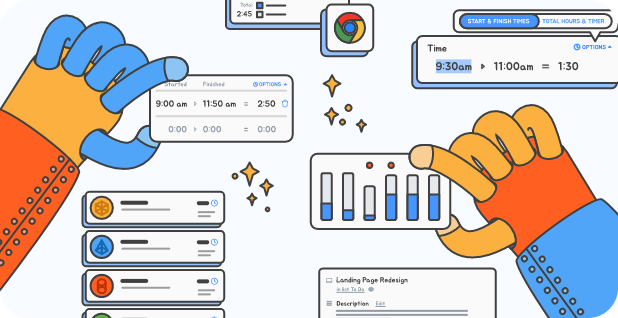Tracking Volunteer Hours
How to track volunteer hours in 2025
Tracking hours has always been an essential part of managing community programs, nonprofit initiatives, and student service requirements. In 2025, however, monitoring volunteer work effectively is more than just keeping a record-book — it’s about accountability, engagement, and impact. As modern organizations, schools, and nonprofits increasingly rely on digital tools to complete all different kinds of work, it only makes sense that time tracking becomes part of that process.
Whether you’re a student logging community service for college, a nonprofit organization managing events, or a local group coordinating fundraising, knowing how to record, manage, and report on your team’s volunteer time can make all the difference.
Why tracking volunteer hours matters
The importance of volunteer hour tracking goes beyond compliance or paperwork. Recording service hours helps organizations understand the scale of their community impact, secure funding from donors, and ensure every person who volunteered gets proper recognition.
- Measure community impact: Accurately recorded volunteer hours help nonprofits and schools quantify their impact in the community. Knowing exactly how many hours were contributed helps communicate value to donors, government agencies, and supporters.
- Accountability and transparency: When organizations can prove the time spent on various tasks or events, they strengthen credibility and trust among stakeholders.
- Recognition and motivation: Providing proof of service hours encourages continued participation. Students and volunteers can log their own hours and celebrate milestones.
- Simplifying administration: Modern time tracking tools reduce paperwork, save administrative time, and help nonprofits stay compliant with government or grant requirements.
Traditional methods of tracking volunteer hours
For decades, organizations relied on paper sign-in sheets or manual forms to record volunteer hours. While this approach still works for small groups, it’s prone to human error and lost data.
- Paper forms and spreadsheets: Many schools, colleges, and nonprofits still use an Excel spreadsheet or printed sheet to track hours. Supervisors then manually log totals and compile reports.
- Signature verification: Supervisors or project managers sign off on volunteer timecards as a form of proof or verification.
- Manual reporting: Staff must collect and summarize data each week, a process that can be time-consuming and inefficient.
While these methods provide a basic recording system, they’re hard to scale and don’t offer insight into progress, engagement, or overall program performance.
How to track volunteer hours digitally
In 2025, how to track volunteer hours has become much simpler thanks to intuitive hour tracking platforms, cloud-based apps, and mobile tools. These systems save time, automate reporting, and give organizations real-time insight into participation.
1. Use a digital time tracking tool
Modern apps allow volunteers to log their hours directly from a site, smartphone, or website. Many also include features like:
- Automated report generation
- Shift scheduling and reminders
- Integration with QR codes for quick sign-ins
- Verification tools for supervisors
A volunteer simply signs in at the event or logs their own hours at the end of a week. The organization can then view total hours per person, program, or event — making tracking seamless.
2. Cloud-based volunteer management systems
For larger organizations or schools, cloud systems centralize all data in one place. Every volunteer can access their profile, update records, and track progress. Administrators can then export reports, monitor shifts, and identify high-impact projects.
3. Integrated scheduling and reporting
Newer tools combine scheduling, time tracking, and reporting in a single platform. This gives coordinators the ability to plan events, assign tasks, and measure total hours — all without additional paperwork.
4. Automation and mobile access
Mobile apps have become essential for volunteer hour tracking. With automatic reminders, easy sign-ins, and mobile access, they make participation more convenient and accurate. Some platforms even use QR codes so volunteers can scan into an event, automatically recording their time spent.
Best practices for tracking volunteer hours
No matter what system you use, consistent processes help ensure accuracy and fairness. Here are proven ways to track volunteer hours effectively:
1. Set clear guidelines
Establish what counts as service hours — meetings, preparation time, travel, or direct community service. Ensure volunteers understand responsibility for accurate logging.
2. Encourage self-recording
Empower volunteers to log their own hours through an online system or app. When people take ownership, accuracy and engagement improve. This also helps students meet their school or college community service requirements.
3. Verify and approve
Designate a supervisor or coordinator to approve records weekly. This ensures that data is verified before inclusion in official reports.
4. Generate insightful reports
Use reports to analyze which events or programs attract the most participation, and where more support might be needed. Reports also help demonstrate impact to donors, government, or partners.
5. Recognize and reward
Empower volunteers by celebrating milestones like “100 hours volunteered” or “Top volunteer this month.” Recognition programs engage students and build lasting commitment.
Tracking volunteer hours in schools and colleges
Many high schools, colleges, and universities now require students to record a specific number of service hours to qualify for graduation or acceptance programs. Proper hour tracking ensures fairness and compliance.
- Schools can integrate time tracking systems to make it easier for students to log their community service.
- Supervisors or teachers can verify records and automatically report totals to the administration.
- Digital tools make it easy to collect data, monitor progress, and prove that students have completed their tasks.
By digitizing volunteer hour tracking, schools can save time, reduce paperwork, and focus on inspiring students to serve the community.
Benefits of using technology to track volunteer hours
Switching from manual methods to digital volunteer hour tracking offers numerous advantages:
- Efficiency and accuracy: Eliminates manual entry errors and keeps all data secure in one system.
- Time savings: Automated reports and scheduling free up staff for more meaningful tasks.
- Transparency: Real-time recording helps ensure every volunteer gets credit for their time spent.
- Accessibility: With cloud access, volunteers and coordinators can log or review hours from any site or device.
- Impact measurement: Easily identify your top contributors, total hours, and the overall effect of your programs.
Challenges in volunteer hour tracking
Even with modern systems, organizations face several challenges:
- Incomplete records: Some volunteers forget to sign in or log their hours.
- Verification delays: Without clear supervisor approval processes, reports can lag.
- Data consistency: Mixing paper forms and digital tools can lead to fragmented records.
- Budget limits: Smaller non-profits may hesitate to adopt paid software.
However, many free or low-cost solutions exist to help organizations overcome these barriers while still improving accuracy and efficiency.
Features to look for in a volunteer hour tracking app
If you’re looking to track volunteer hours more efficiently in 2025, choose a system that includes:
- Easy sign-in options: Allow volunteers to log hours via mobile, QR codes, or web forms.
- Automated reports: Generate total hours, progress, and event summaries with one click.
- Supervisor verification: Ensure accountability and proof of participation.
- Scheduling and shift management: Assign tasks and events directly within the system.
- Data export and access control: Keep records secure but shareable for government, donor, or school requirements.
- Integrations: Connect with existing tools like spreadsheets, HR systems, or fundraising platforms.
How to engage and empower volunteers
Tracking time is only part of the equation. The real goal is to empower volunteers and make their experience rewarding.
- Provide clear feedback on progress toward total hours or goals.
- Share how their volunteer time supports the community.
- Use digital dashboards or leaderboards to engage students and participants.
- Send appreciation posts on your site or social media to highlight top contributors.
This not only motivates existing participants but also strengthens volunteer recruitment for future programs.
Using Hourly to track volunteer hours
One of the easiest tools for tracking volunteer hours in 2025 is Hourly. Originally built for time tracking and workforce management, HourlyTime’s intuitive design makes it ideal for nonprofits, schools, and organizations that need a streamlined way to track volunteer hours.
Here’s how it can help:
- Simple logging: Volunteers can quickly log their own hours through the website or mobile app.
- Automated reports: Coordinators can instantly generate reports on total hours, events, and program participation.
- Accurate recording: The app helps ensure every minute spent is properly recorded, reducing the risk of missed hours.
- Efficiency: It helps save time on administration and paperwork, freeing teams to focus on what matters — community impact.
ser-friendly features, HourlyTime.com provides organizations with a modern, efficient solution for volunteer hour tracking that scales effortlessly from small groups to large nonprofits.
Looking forward
In 2025 and beyond, the way we track volunteer hours will continue to evolve — moving further away from paper forms and manual Excel spreadsheets, and toward smart, automated systems that measure impact, encourage engagement, and simplify management.
Whether you’re managing a high school community service project, coordinating a college outreach program, or leading a global nonprofit, adopting digital tools for hour tracking ensures you can record, verify, and celebrate every volunteer contribution.
By leveraging modern apps like HourlyTime.com, you can bring your organization forward — creating a system that not only counts hours, but truly values them.












